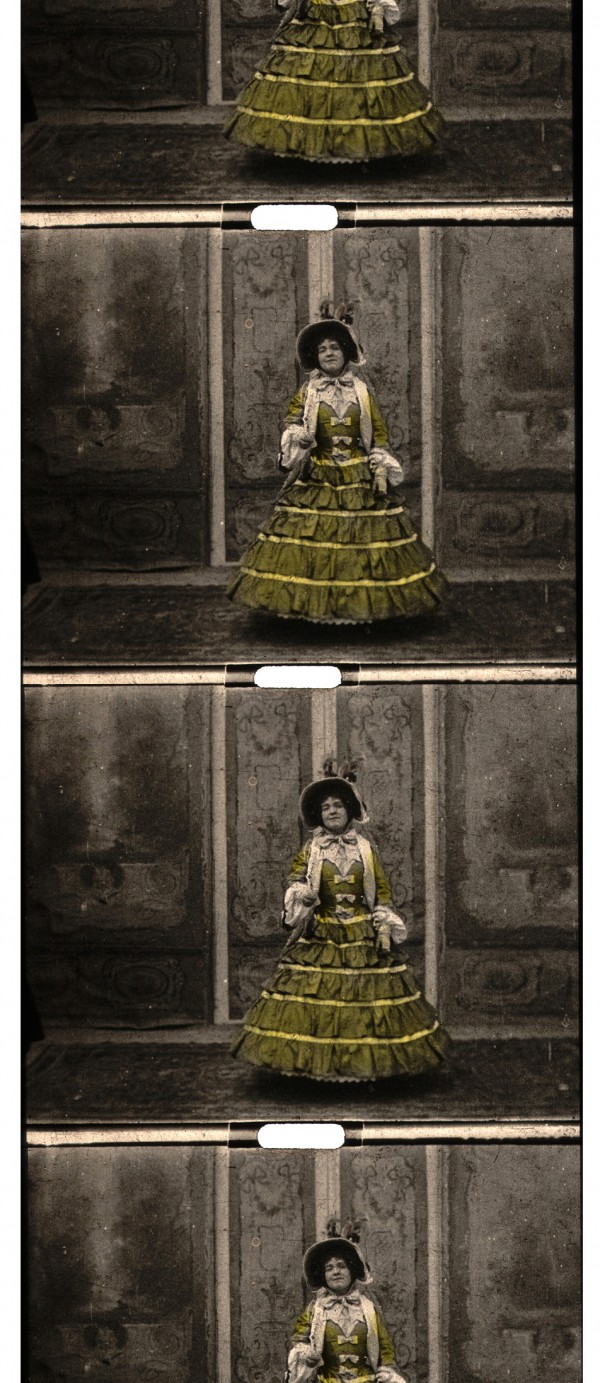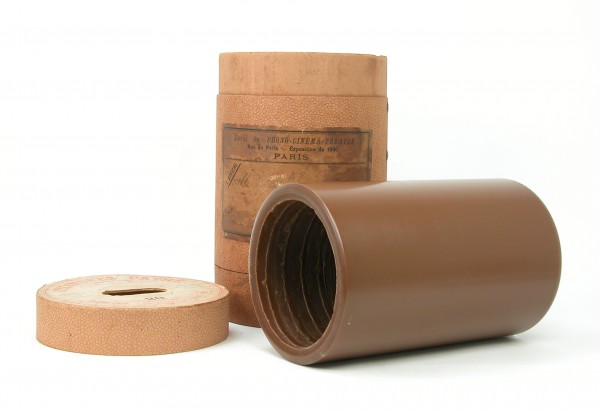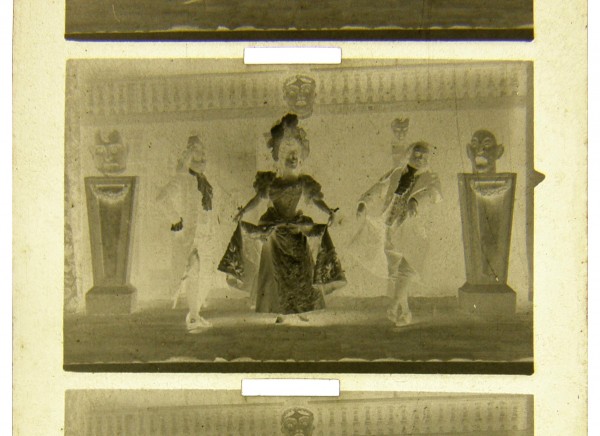An early cinema sound system that synchronized 35mm film prints with cylinder recordings.
Film Explorer

A hand-colored 35mm Parnaland print of Deux Chansons en crinoline (1900), featuring Mlle. Mily-Meyer. This mute 35mm print was synchronized to a wax cylinder containing the audio.
Cinémathèque française, Paris, France.

Phono-Cinéma-Théâtre films synchronized a mute 35mm print with audio recorded and played back from a wax cylinder.
Cinémathèque française, Paris, France.

A 35mm Parnaland negative of La Poupée (1900).
Identification
Unknown
Approx.
One perforation between the frames, at the center of the frameline or two perforations between the frames, at the extremities of the frameline.
B/W, orthochromatic.
None
1
Films were either B/W or hand-colored.
None
A mute 35mm film print was synchronized with a phonograph cylinder (22cm long, 13cm in diameter).
Approximately 28.2mm x 19.7mm (1.11 in x 0.78 in).
One perforation between the frames, at the center of the frameline, or two perforations between the frames, at the extremities of the frameline.
B/W, orthochromatic.
None
History
At the dawn of the twentieth century, the innovations represented by the phonograph (in vogue at the time) and the cinematograph inspired both inventors and artistic personalities. While experiments in synchronism of sound and image multiplied, the actress and member of the Comédie Française, Marguerite Vrignault, dreamed of reproducing the famous acts of stage celebrities on the screen. This led to the Phono-Cinéma-Théâtre enterprise and the creation of a company of which was registered on March 2, 1900. The technical aspects were supervised by Clément Maurice, a photographer, who had worked with the Lumière brothers at the Monplaisir factory.
Marguerite Vrignault designed a film studio where it was possible to record cylinders of live performances. This studio was located on the roof of the pavilion of the Phono-Cinéma-Théâtre at the Exposition Universelle / 1900 Paris Exposition (located in the rue de Paris, door 43, Le pont des Invalides). Some of the sets and painted backgrounds of the studio are easily recognizable in the preserved films. One can also recognize the reproduction of the Théâtre de la Gaîté used for the duel scene in Cyrano and La Poupée.
While the union of the phonograph and the moving image was the main marketing thrust, it is interesting to note that not all of these films were accompanied by a phonograph. As far as we know, only the songs, operettas or operas, and the two scenes performed by Coquelin aîné [Coquelin the Elder] (Benoît-Constant Coquelin) were recorded. Certain scenes, such as Hamlet's duel, were accompanied by live Foley artists, recreating the clash of swords in synchronization with the picture. Other scenes were accompanied by an orchestra – notably, the dances and the pantomime from L'Enfant prodigue with music by André Wormser; La Korrigane, with music by Charles-Marie Widor, a ballet first performed at the Opéra on December 1, 1880; Le Rêve by Léon Gastinel, with choreography by Hansen, performed at the Opéra in June 1890; the Danses slaves and Caroles du Moyen-âge, with an arrangement by William Marie; and, finally, the Danse directoire and Gavotte, with music by Samuel Rousseau. This operetta is one of the few surviving films with an accompanying cylinder – as are an opera aria from Romeo and Juliet and two comedies (Cyrano's duel scene and Les Précieuses ridicules). The songs of Mily-Meyer, Pougaud and Jules Moy were also recorded for sound projection.
Although some of the films were shot around the same time as the initial screenings in April 1900, the newspaper Le Gaulois reported that several performances, notably the plays with Réjane, were filmed as late as September 1900.
Contemporary articles published in the press were often very positive and their accounts of the protagonists enthusiastic, yet the operating accounts suggest that the attraction was not a great success, in contrast to the Exposition as a whole.
However, the life of the Phono-Cinéma-Théâtre would not end with the Exposition. From November 1900 onwards, Félix Mesguich, who had worked with Auguste Baron before and during the Exposition, toured Europe for three months with the Phono-Cinéma-Théâtre through Germany, Austria and Switzerland. The attraction also toured to Sweden and around France. Marguerite Vrignault, who succeeded Paul Decauville as president of the company, installed the show at the Olympia, the Isola brothers' Parisian theatre, at the beginning of 1901. At the end of the year, the company Phono-Cinéma-Théâtre was dissolved, despite the attraction still touring, mainly abroad, for some months – according to Historian Thierry Lecointe, some films were screened until 1907.

(Left to right) Hand-colored scenes from Little Tich (1900), Cléo de Mérode in Gavotte (1900), and Hamlet, scène du duel (1900) with Sarah Bernhardt. All three were originally presented as silent films. These films have been restored by the Cinémathèque française.
Cinémathèque française, Paris, France.
Selected Filmography
Sung by Mlle Hatto de l’Opera. Presented with synchronized sound.
Sung by Mlle Hatto de l’Opera. Presented with synchronized sound.
Sung by Cossira de l’Opera. Presented with synchronized sound.
Sung by Cossira de l’Opera. Presented with synchronized sound.
Written by Edmond Rostand; performed by Coquelin Aîné and Desjardin. Hand coloured. Presented with synchronized sound.
Written by Edmond Rostand; performed by Coquelin Aîné and Desjardin. Hand coloured. Presented with synchronized sound.
Sung by Mlle Mily-Meyer. Presented with hand coloring and synchronized sound.
Sung by Mlle Mily-Meyer. Presented with hand coloring and synchronized sound.
Sung by Mlle Mily-Meyer and M. Pougaud. Presented with synchronized sound.
Sung by Mlle Mily-Meyer and M. Pougaud. Presented with synchronized sound.
Pantomime with Mme Sarah Bernhardt, M. Pierre Magnier (Laërte), Mlle Seylor, and Hommes d’armes. Presented with hand coloring, but without synchronized sound.
Pantomime with Mme Sarah Bernhardt, M. Pierre Magnier (Laërte), Mlle Seylor, and Hommes d’armes. Presented with hand coloring, but without synchronized sound.
This film was originally presented with hand coloring without synchronized sound. A soundtrack was added in 1933.
This film was originally presented with hand coloring without synchronized sound. A soundtrack was added in 1933.
Sung by M. Louis Maurel. Presented with synchronized sound.
Sung by M. Louis Maurel. Presented with synchronized sound.
Sung by M. Jules Moy. Presented with synchronized sound.
Sung by M. Jules Moy. Presented with synchronized sound.
Music by Ed. Audran, performed by Mariette Sully, MM. Fugère and Soums. Presented with synchronized sound.
Music by Ed. Audran, performed by Mariette Sully, MM. Fugère and Soums. Presented with synchronized sound.
Adapted from Molière. Performed by Coquelin Aîné, Mlle Esquilar and Kervich (or Kerwick?). Hand-colored. Presented with synchronized sound.
Adapted from Molière. Performed by Coquelin Aîné, Mlle Esquilar and Kervich (or Kerwick?). Hand-colored. Presented with synchronized sound.
Sung by M. Polin. Presented with synchronized sound.
Sung by M. Polin. Presented with synchronized sound.
Technology
Henry Cossira (son of the famous tenor) reported in L’Image in 1933:
“Two years before the opening of the Exposition [Universelle in 1900], Mrs. Chenu reminded me [of] the interest there would be in reconstituting in animated visions the acting and voice of our greatest artists. [The industrialist] Paul Decauville was won over and encouraged me to put my idea into practice and set up a limited company of which he was willing to take to the board of directors. I was thus able to have my pavilion built and having approached the Lumière brothers, they advised me to take on Clément Maurice as operator. I found Maurice working with Doctor Doyen, and I did not regret it, because he is a true artist.”
Clément Maurice was asked by the famous surgeon Eugène-Louis Doyen to film his operations, in June 1898. At his side was Ambroise-François Parnaland who, even if his name is totally absent from the enterprise, should be recognized behind these words from the Le Figaro (June 8, 1900):
"When watching the cinematograph, one is surprised by an absolutely perfect sharpness and fixity in the reproduction of scenes. This is a progress which is not trivial, and which is due, in part, to the prestigious skill of the operator and, in part, to new improvements brought to the construction of the apparatus by a very famous surgeon of legendary skill and boldness, who devised these improvements by using the cinematograph on his own account.”
The "very famous surgeon" is none other than Doctor Doyen. Thus, when Clément Maurice was appointed in charge of the technical part of the Phono-Cinéma-Théâtre, he chose the Cinépar camera by Parnaland, which had the qualities praised by the article.
For the sound, Henri Lioret, known for the quality of his recordings and the manufacture of phonograph cylinders, was called upon. Shortly before the 1900 Exposition, Lioret had put a new phonograph model on the market, the Idéal, which presented all the required characteristics for synchronization with moving images: “Power, an electric movement capable of supporting almost continuous operation, wax cylinders allowing the recording of artists in the small studio and a duration of four minutes” (Anton, 2006: pp.60–1). The way in which synchronous films were made varies according to the account. According to Henry Cossira, “the operator, Clément Maurice, first shot the film, then at the same speed, the cylinder was recorded”; while according to Léopold Maurice (Clément's son): “the artists [mimicked] the phonographic recording that they had previously made”. The synchronism was achieved manually by the operators – Léopold Maurice and his brother Georges – and was not precise. Projection speed had to be continually adjusted to keep in synch with the cylinder recording. According to the newspaper Le Gaulois, the Phono-Cinéma-Théâtre replaced the Idéal phonograph in September 1900 with a new model: the Céleste by Pathé.
Some technical malfunctions may well have disrupted the smooth running of the sessions, such as the frequent power cuts reported by L'Intransigeant (June 8, 1900: p. 3):
"There are many problems that the public experiences as soon as they pass the ticket booths of the Exposition. One of the most serious is the daily suppression of all electric lighting in the various parts of the vast fair. There is not an evening that goes by without [loss of power] in the middle of the shows, in the centres of attraction or in the streets.”
[Editor’s Note: Please see the entry on Parnaland for more details on that format.]
References
Anton, Julien (2006). Henri Lioret. Un horloger pionnier du phonographe. Paris: Cires.
Cinémathèque française (n.d.). Catalogue des restaurations et tirages de la Cinémathèque française : Phono-Cinéma-Théâtre. https://www.cinematheque.fr/catalogues/restaurations-tirages/film.php?id=117674#technique (accessed August 13, 2024).
Cossira, Henry (1933). “La résurrection du Phono-cinéma-théâtre de l’Exposition 1900”. L’Image, 55 (March 31): pp. 23–7.
Hurm, Horace (1943). La passionnante histoire du phonographe suivie de la première méthode pour en «jouer avec art». Paris: Les publications techniques.
Lange, Eric (2012). “L’exploitation du cinéma sonore en France avant 1914”. In Alice Guy, Léon Gaumont et les débuts du film sonore, Maurice Gianati & Laurent Mannoni (eds), pp. 141–84. Barnet, Herts: John Libbey Publishing Ltd.
Mesguich, Félix (1933). Tours de manivelle. Souvenirs d'un chasseur d'images. Paris: Grasset.
Olsson, Jan (1999). “In and out of Sync: Swedish Sound Films 1903-1914”. Film History, 11:4 (April): pp. 449–55.
Toulet, Emmanuelle (1986). “Le cinéma à l'Exposition universelle de 1900”. Revue d'histoire moderne et contemporaine, 33:3 (Apr–Jun): pp. 179–209.
Vivié, Jean (1969). “Léopold Maurice. Témoin des débuts du cinéma” [interview]. Bulletin de l’AFITEC, 29: p. 6.
Preceded by
Compare
Related entries
Author
Camille Blot-Wallens is an independent film historian, researcher, and archivist. She studied History at University Paris 1 and Film Archives at University Paris 8 and the European program Archimedia. She started collaborating with Filmoteca Española in 2000 as independent researcher, and more specifically on the identification and analysis the Sagarmínaga Collection (1895-1906) together with Encarni Rus Aguilar and the Joly-Normandin films of the Sagarmínaga collection and Anacleto Rodrigues Collection from Cinemateca Portuguesa. Alongside, she obtained the grant Lavoisier from the French Ministry of Foreign Affairs (2001) to assist Luciano Berriatúa on the restoration of Der letzte Mann (F. W. Murnau, 1925) and continued working with him on other Murnau’s films for the Murnau-Stiftung. In 2007, she joined the Cinémathèque française as Head of the Films Collections. Since 2012, she has been an independent researcher and historian residing in Stockholm, where she works on restoration and research projects for European and International archives. Member of the FIAF Technical Commission since 2012, she takes part to numerous trainings for archivists, and she recently edited a new, enriched edition of Harold Brown’s Physical Characteristics of Early Films as Aids to Identification for FIAF (2020). Camille is also associate professor at the University Paris 8 Vincennes – St-Denis, where she is co-responsible of the Master in Film Studies, Specialisation Film Heritage, and she is also a lecturer at University of Lausanne where she runs a workshop on conservation and restoration as part of the Cinema Network (Réseau Cinéma CH). In 2018, she was recipient of the Jean Mitry Award (Giornate del cinema muto, Pordenone – Italy) and of the The Outstanding Achievement Award for Film Preservation (Film Heritage Foundation, Mumbai – India). In 2019, she was invited to honour Film Preservationist Harold Brown giving the Jonathan Dennis Memorial Lecture during Il Giornate del cinema muto and the Ernest Lindgren Lecture at the British Film Institute.
Laurent Mannoni, Henri Chamoux, Sébastien Martineau.
Blot-Wellens, Camille (2024). “Phono-Cinéma-Théâtre”. In James Layton (ed.), Film Atlas. www.filmatlas.com. Brussels: International Federation of Film Archives / Rochester, NY: George Eastman Museum.


